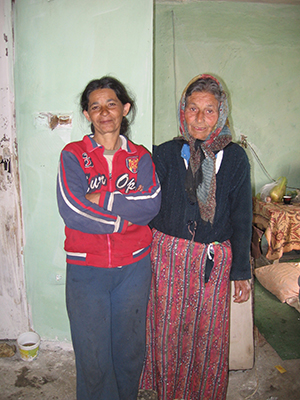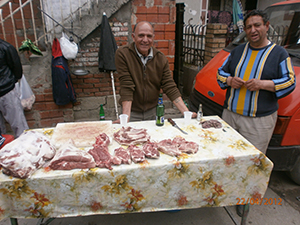Loving Our “Unwanted” Neighbors

She grew up conscious of the Roma (Gypsy) presence but had no more thoughts of them than the usual stereotypes: they are filthy and they steal, their yards look like junkyards and they do not want to work. Although Anita1 would see them begging, she felt no particular compassion or empathy for them. When she quit her job and submitted her life to serve God, she imagined that God might send her to Africa—she had little idea that she would, in the near future, begin to be part of many Roma lives in a community near her home.
My research among Roma communities in the Balkans over the last year highlights a consistent yet strange irony found in missional praxis—a truth that first struck me when I read The Brothers Karamazov years ago. “I MUST make one confession,” Ivan began. “I could never understand how one can love one’s neighbors...One can love one’s neighbors in the abstract, or even at a distance, but at close quarters it’s almost impossible.”2
 Why does our compassion so often scab over in response to those closest, and most unlike us, even as our hearts burn with passion for “those in need” who are far off? Perhaps Jesus told his parable of the Good Samaritan in order to elicit a visceral reaction regarding the true challenge of loving our neighbor—a reaction we can experience today if we take out the word Samaritan and insert a neighbor with whom we share close physical proximity but try to avoid. In fact, despite changing paradigms in 21st Century missiology, the word “mission” and “missionary” often still hold an implicit meaning of being “far off and distant.”
Why does our compassion so often scab over in response to those closest, and most unlike us, even as our hearts burn with passion for “those in need” who are far off? Perhaps Jesus told his parable of the Good Samaritan in order to elicit a visceral reaction regarding the true challenge of loving our neighbor—a reaction we can experience today if we take out the word Samaritan and insert a neighbor with whom we share close physical proximity but try to avoid. In fact, despite changing paradigms in 21st Century missiology, the word “mission” and “missionary” often still hold an implicit meaning of being “far off and distant.”
The reasons for this are not merely peripheral—in fact, it is imperative that we understand the why behind this issue, perhaps unique in every context, so that we can effectively address the how in rethinking proximal mission in a given context. There is most likely a complex web of historical, cultural, personal, spiritual, and social factors at play that feed into disregard for the other at close proximity.
I have tried to analyze this issue in my research among Roma communities in the Balkans—communities that have very little missional contact from the surrounding Catholic, Orthodox, and Protestant churches. However, I proceed with caution in this venture of understanding the why in this context. It is always easier to identify another culture’s “Samaritans” and likewise pass judgment, even as we remain blind to our own. In this regard, I am mindful of Jesus’s admonition in Matthew 7:3-5 to “take first the log out of your own eye.”
At 10-12 million, the Roma make up Europe’s largest minority and yet remain largely invisible.3 The poverty and educational levels are often far below the average in each respective European country, and their history showcases a theme of disregarded suffering. It cannot be said, however, that this marginalization is simply due to ongoing discrimination—they are not passive agents in their own history. Rather, there are elements within the Roma culture itself which contribute to the separation from the surrounding culture. Even after over 800 years of being in Europe, the Roma remain not only distinctly “cross-cultural,” but also profoundly unwelcome and unwanted. Although there are exceptions, Roma communities in the Balkans hardly register on the local church’s missional radar screen. “Nobody wants to accept the Roma,” one Roma pastor in Serbia declared to me. “Not the traditional [Serbian Orthodox] church, not the Protestant church...so now is the time we can make our own church for the Roma.”4
Confronting Historical Barriers
The Roma are not new neighbors in the Balkans—the first historical account documented their appearance in the late 1200’s.5 Therefore, history plays an important role in current perceptions of the Roma. Unfortunately, the church’s historic attitude towards the Roma has often been a double-edged sword—faulting them for being pagan while showing scant inclination to include them in the church. In fact, the church was complicit in forced conversion, limiting access to sacraments, taking children away from Roma families to raise in “non-Roma homes,” and forcing segregation from the church.
Although there is no simple explanation for this reaction, their identity was often interwoven around religious folklore, fostered both by the church and the Romanies themselves. In the fifteenth century, some Roma groups secured “letters of protection” from nobility by claiming to be wandering in penance for abandoning Christianity and returning to paganism.6 Other folklore claimed that they had constructed the nails by which Christ was crucified and they refused sanctuary to baby Jesus and Mary when they fled to Europe. The suspicions surrounding Roma identity increased because of their skin color, serving to portray them as “non-white, heathen outsiders.7 Finally, their spirituality deepened the religious antagonism against them—their practice of magic, palmistry, and fortune telling. “It is certain that the Gypsies have at all times been godless, wicked people who are harried with complete justification,” declared the Universal Dictionary of all Sciences and Arts, published in 1749.8
In fact, often we construct our unwanted neighbors’ identity around some measure of “folklore” derived from negative incidents, history, the media, or first impressions. This forms our assumptions and colors our perceptions toward them. If we are not careful, this puts us in a posture of “bearing false witness” against our neighbor, as we sum up who they are with quick cliches or stereotypes that do not come from actual relationship.
When Anita first visited a Roma home, she was wary, half-expecting that they would try to steal from her. But she was surprised at their openness and their welcome, and when trust began to form, she realized that they were treating her like one of them. Her expectation would not be unusual—most of the majority culture in the Balkans knows little about the actual culture of the Roma, and their perception is filtered through stereotypes that have been present for centuries. But even as the historical legacy promulgates deep feelings of suspicion toward the Roma, the ongoing cultural divide is at least partially maintained by disapproval of their lifestyle and fear of their potential economic demands.
Confronting Socio-Economic and Cultural Barriers
“But you’ve seen how they live,” one earnest student asked me in my missiology class. “It is easy to say that we need to love and reach out, but how do you suggest dealing with your neighbor when their front lawn is full of garbage?” I had posed a case study to my students from recent events that took place in a small Croatian village. After a Roma family moved into a village unfriendly to outsiders, they came under great pressure from the community to leave again. Finally, the community built a fence around the Roma home to “keep them in.” This action was roundly condemned by the Croatian president, but it displays a disturbingly graphic picture of what we may feel in our hearts toward our unwanted neighbors.
 Christine Pohl, in her book Making Room: Recovering Hospitality as a Christian Tradition, discusses this inclination in humanity to turn away from the stranger, to view them as an enemy, the one not like us. “We seldom notice how substantially bounded our private worlds are—how few ‘unknown’ strangers we welcome, nor do we recognize how frequently the boundaries are socioeconomic.”9 She points to a number of factors contributing to this response: a steady diet of media images portraying gratuitous need in distant locations that paralyzes us from local involvement, a feeling of ill-will against neighbors who seem detached from social responsibilities, or people feeling inundated with “cultural difference or socio-economic need” of the other.10
Christine Pohl, in her book Making Room: Recovering Hospitality as a Christian Tradition, discusses this inclination in humanity to turn away from the stranger, to view them as an enemy, the one not like us. “We seldom notice how substantially bounded our private worlds are—how few ‘unknown’ strangers we welcome, nor do we recognize how frequently the boundaries are socioeconomic.”9 She points to a number of factors contributing to this response: a steady diet of media images portraying gratuitous need in distant locations that paralyzes us from local involvement, a feeling of ill-will against neighbors who seem detached from social responsibilities, or people feeling inundated with “cultural difference or socio-economic need” of the other.10
As the economic situation grows more challenging for everyone in the Balkans, perhaps there is a fear that one’s neighbor may demand too much—giving a little could open the floodgates of need, especially if we disapprove of how our neighbors live. Unpredictable outcomes can stymie relationship, particularly if there is a lot at stake. One Croatian pastor explained his hesitancy to include Roma in the church because of prior incidences of Roma attendance splitting a church. Another pastor admitted his relief that Roma stopped coming to his church so that Croatians would once more want to come.
One cannot merely dismiss or minimize these concerns. It is difficult to live next to someone who has different priorities and different cultural norms. What is to be done if a pastor loses most of his congregation because of Roma involvement—a congregation that contributes to the offering which helps maintain the church programs and building? What does a church do if by reaching out to unwanted neighbors, it loses its own identity in the process? Even if God might be doing something new with a church’s identity, the prospect of losing what is comfortable and known is always difficult and painful. But perhaps some kind of death is always a prerequisite of new birth.
Of course it is not possible to confront the socio-economic and cultural barriers without beginning a relationship—and being willing to accept both the risk and the joy that accompanies that beginning. “I found out that although of course there are some Roma who are messy like in any culture, “ Anita told me, “many Roma earn their livelihood by hunting for scrap metal in junkyards and trash. Much of this metal gets sorted and stripped in the front yard of a Roma home.” Relationship not only highlights truth behind the stereotypes and reasons for cultural behavior, but serves to illuminate our own self-erected barriers—our fears, our sin, our commitment to personal comfort and familiarity.
Confronting Personal Prejudice and Fears
It can be painful to consider a missional approach to the communities we feel most reluctant about—it forces us to confront our own hearts and our lack of commitment to love. Why do I feel no qualm about stepping over a passed-out homeless man in Portland, Oregon, my hometown? Why does a Croatian church not care that a nearby Roma village is in such dire poverty that some houses do not have doors? Is it because I am tired and feeling overwhelmed by work and my previous commitments? Am I worried that too many people will ask me for money? Perhaps I will be confronted with hard questions?
The narrative of Jesus’ life is bent around the central principle that to “save one’s life, one must first lose it.” Losing one’s life may look different in different contexts, but it demands that we submit to Jesus our own personal comfort, our ideas of mission, and how we think people should act and think. Such a surrender in the context of relationship with our neighbor can lead to a certain identification with them. When Anita proposed to her church that they put together shoeboxes for the children in a nearby Roma village for Christmas, the church stalled on its decision. Finally, Anita heard that it had been vetoed because people were afraid of exposing their own children to diseases by going into the Roma village. Anita found herself angry and offended—although the offense was not aimed at her, her identification with the people allowed a righteous anger at the misinformed prejudice and judgment.
And yet, moving in relationship toward the other does not often end in a neatly tied up happy ending. At one point, Anita was ostracized from the Roma community by making an unintentional but serious cultural mistake—after a woman had lost a baby, Anita had gone outside to talk to her husband alone, a cultural taboo. Soon, rumors and gossip were flying around the community and Anita struggled with fear and worry about what this meant for her ministry. She felt rejected after she had poured herself into the community.
“Still,” she said, “I had a big love for the people that this pain could not quench and I wanted to keep being involved. “
Confronting Our Limited Ideas of Mission
God continues to reveal himself in Roma communities through miracles, dreams and visions and the Roma expression of faith differs radically from the majority culture around it— therefore the few non-Roma that venture into the community find themselves blessed in unexpected ways. When the woman that Anita had offended finally asked for forgiveness for her behavior, Anita was astonished at her humility and open repentance—an expression of the gospel that she rarely saw in Croatian churches.
Anita’s journey is a powerful image of mission as a multi-directional catalyst. As we participate in God’s mission, our own understanding of God deepens and our ability to love increases through the ones we are serving. If the kingdom of God begins as a mustard seed, we must step out of our groomed orchards and manicured lawns to poke around in unexpected and unlikely places—will we be able to recognize it when it is only a small seedling?
The Courage to Recognize the Mustard Seed
In 1950, a French Roma woman’s son was miraculously healed and consequently her family converted. However, evangelists refused to baptize them or allow them to take communion because they were not legally married according to French law. Disturbed by this, Pastor Clement Le Cossec arranged for both legal marriages and baptisms, and thus began his involvement in what became the rapidly growing Gypsy Evangelical Church. In 1958, the number of baptized had reached 3,000 and Le Cossec quit his involvement in the Assemblies of God Church to work exclusively within the independent Gypsy Evangelical Church. In its first three decades, the Gypsy Evangelical Church reportedly baptized around 70,000 members.11
In the 1970’s, Pastor Mio Stankovic pastored a small church in Leskovac, Serbia. Although there were thousands of Roma living in and around Leskovac, he gave little thought to them. However, one day a Roma woman came to him and asked for prayer. After he prayed, she was healed. By the late 1980’s, Roma continued to come to the church as a result of the numerous healings and miracles taking place. By 2004, the church had grown from 30 people to 1,000 members.12
After a year and a half forming relationships with and discipling our Roma neighbors, Anita and I can see the small seedling pushing its head up from the soil. Our Roma partners in this endeavor decided that the time was ripe to begin a church. The first service, held in November 2012, was celebrated with two pigs and much festivity. In preparation, new Roma believers weed-whacked the property, chopped down unruly trees, replaced windows, and painted the old building. We watched with awe in our hearts and certain expectation of what God was doing. Although it is easier for us to love the idea of the other than the actual other, Jesus’ mandate requires us to move into this uncomfortable, unpredictable, and even sometimes dangerous territory. This is precisely why Jesus told such a disquieting story to the lawyer wishing to justify himself—loving our neighbor, wanted or unwanted, is at the center of mission.









comments